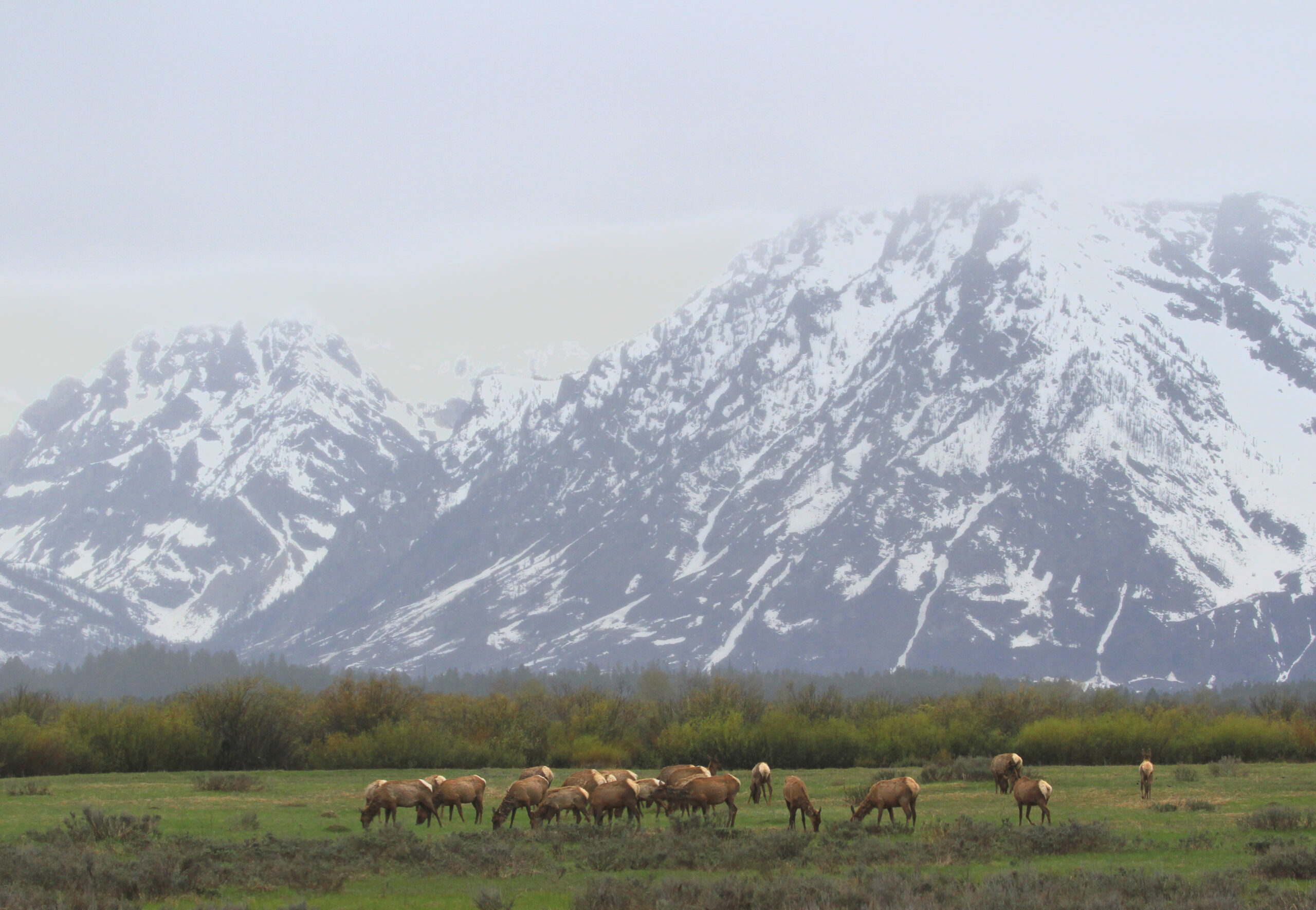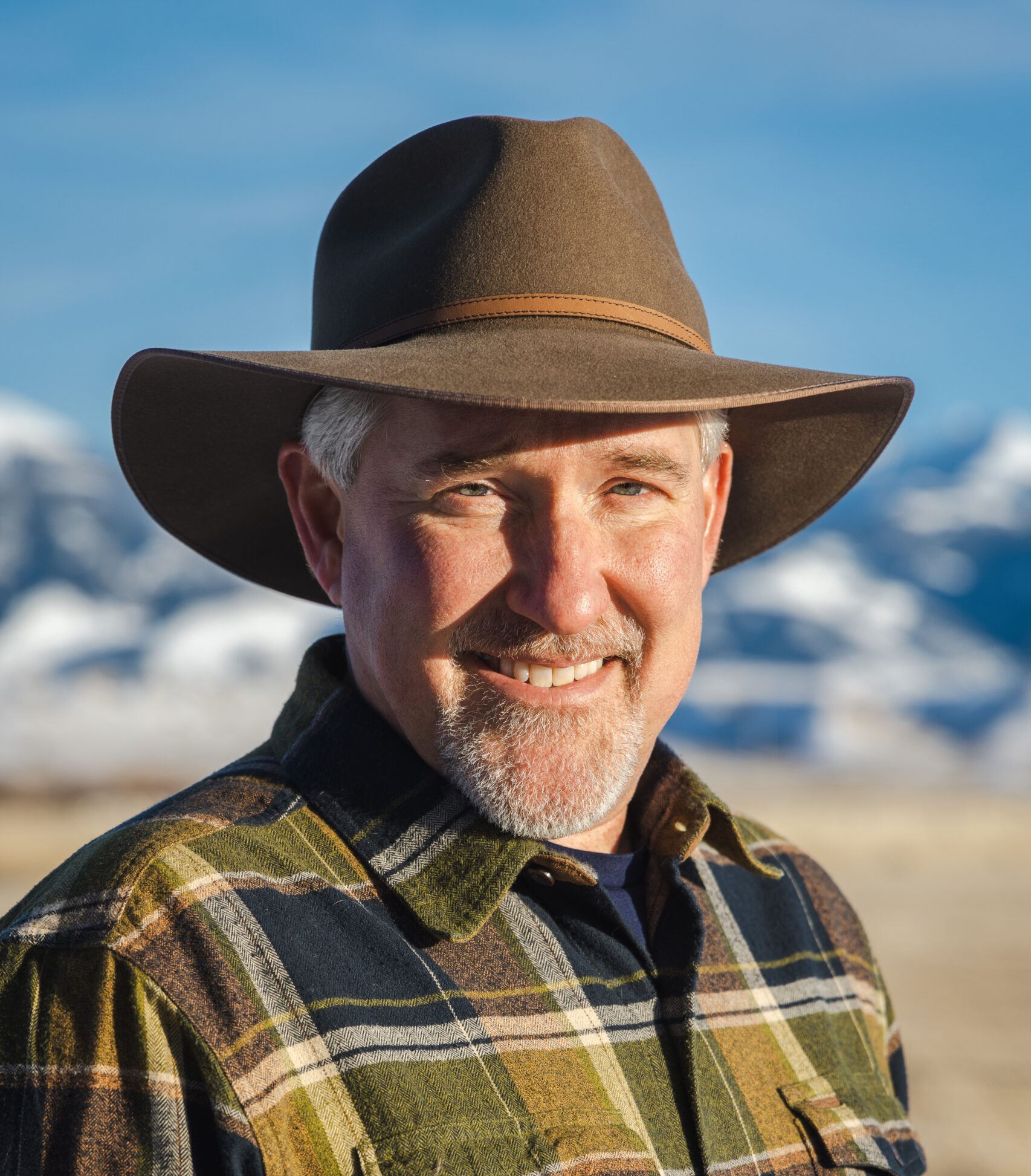Jack leads the way as we climb through the Ishawooa Hills southwest of Cody, Wyoming. When we get to a highpoint, he stops to look up a drainage into the Washakie Wilderness, perhaps anticipating one of his multi-day backcountry adventures. Not today. Jack the dog has brought his human with him, the elk ecologist Arthur Middleton. As one of the foremost experts on ungulate migration in North America, Middleton wants to show us this critical spot. He explains that the Ishawooa Creek watershed, which disappears ominously into the mountains from this vantage point, is a thoroughfare that 4,000 mule deer use seasonally to migrate from the South Fork of the Shoshone River into the high country of Yellowstone.
For thousands of years, migration has been the key to survival for species like elk, mule deer, and pronghorn in this area. And Middleton is the man with the invisible ink pen. Assisted by GPS tracking, his research—millions of geolocated dots on a map—has revealed the paths of these masters of migration as they journey annually from privately owned, low-elevation ranchlands into some of the most rugged terrain in the lower 48 to reach lush summer grasses of high-elevation plateaus.
Lately, there has been a groundswell of support for protecting wildlife migration corridors, and not just for ungulates like elk and pronghorn. Each year, monarch butterflies migrate north through the heartland of the United States—a journey that takes several butterfly generations to complete—only to be carried by the winds back to their wintering grounds in Mexico. Loggerhead turtles use the earth’s magnetic field to migrate in a circle around the Atlantic only to return to the beach of their own hatching to lay eggs. Even timber rattlesnakes migrate—not very far, but enough to make you wary of where you step, as I found out firsthand on a recent visit to privately owned conservation lands in upstate New York.
In the Greater Yellowstone area, Middleton and his fellow scientists study roughly 20,000 elk spread out over nine different herds. For these animals, migration is a strategy to find the best vegetation. It’s called “surfing the green wave.” Newly emerged plants offer the best nutrition, so in springtime elk follow these green shoots up into the mountains. And in the fall, they reverse their steps and retreat from the snow. According to Middleton, this flow in and out of Yellowstone helps sustain the entire ecosystem.
Migration conservation is about finding what works for both wildlife and people.
But there are challenges. Foremost, these migration corridors begin and end somewhere, and that is often on private land. Elk here spend as much as 80 percent of their time in the winter on large cattle ranches. These private lands are critical for healthy migrations. But once elk are on these lands, they compete for winter hay and irrigated alfalfa and can transmit brucellosis, a disease that causes cattle to abort their young. The economic consequences can be dire.
And to the detriment of landowners and the ecosystem, time spent on private lands may be increasing. As wolves and grizzlies grow in number, private ranchlands not only provide a reliable source of food for elk, but also a refuge from predators. Over the past two decades, migratory elk numbers in Wyoming have decreased, while resident elk populations—elk that no longer make the annual migratory journey—have increased. Migratory elk encounter four times as many wolves and grizzlies as resident elk. In the struggle to survive, many elk are staying put.
Finally, mapping these corridors can also be tricky, as not all landowners consider being on a map a good thing. Ranchers often fear that corridor mapping will come along with additional regulations and scrutiny—when most landowners are already being excellent wildlife stewards. As a colleague once observed, in the West, you can bring a gun to a meeting, you just can’t bring a map.
The migration story in the Greater Yellowstone area, where private lands abut protected public lands, is complicated. The fluid nature of migratory animals, personified by spaghetti-like lines on a map, defy geometric solutions. It’s not as easy as putting a square box around millions of acres of land and calling it Yellowstone. The temporal nature of migration also creates unique challenges. Traditional tools like easements require a permanent generational commitment that in some cases may be asking too much of working ranches.
As Middleton knows, research of ungulates and their corridors will also have to include research of landowners and their challenges with migration. At PERC, with partners like Middleton, we are doing just that—taking time to learn from landowners, who are often an afterthought in efforts by governments and other well-meaning conservation organizations. As one multi-generational rancher in Montana’s Paradise Valley told us, “Nobody ever comes and talks to me.”
As part of a multi-year initiative on Yellowstone’s migration corridors, PERC is spending time in ranchers’ kitchens, walking the land with them, conducting landowner surveys, studying long-term land-use patterns, and leading efforts to develop market-based financial instruments that would help landowners address the risks of brucellosis transmission. But why?
Knowledge is dispersed, localized, and particular to individuals, so it defies central planning. And so it may be with migration corridors.
At PERC, we often reference the great Austrian economist Friedrich Hayek’s “knowledge problem.” Knowledge, according to Hayek, is dispersed, localized, and particular to individuals, so it defies central planning. And so it may be with migration corridors. Finding solutions will require a decentralized, dynamic approach that accommodates not only the fluidity of wildlife in motion, but also the diverse range of landowners and the particular geographic, cultural, and socioeconomic features of their varied basins.
Our goal is to develop, through a bottom-up approach, market-based tools and economic incentives to help turn migratory wildlife into less of a liability and more of an asset in the eyes of the private landowners who steward so much of their habitat. The work is time consuming and difficult. Ranch by ranch. Understanding the diversity of landowners is complicated. Diplomacy skills are needed. There will be no one-size-fits-all answer. And the effort will likely entail a whole new set of approaches to policy and conservation, some of which don’t even exist today. That’s where the creative power of free market environmentalism can help.
Migration conservation, at its core, is about finding what works for both wildlife and people. The future of many migrations hinge on the stewardship of private landowners. As Aldo Leopold wrote, “Conservation means harmony between man and land. When land does well for its owner; and the owner does well by his land; when both end up better by reason of partnership, we have conservation. When one or the other grows poorer, we do not.”




